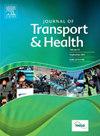Did the built environment attenuate reductions in leisure walking during COVID-19? A quasi-panel study
IF 3.2
3区 工程技术
Q2 PUBLIC, ENVIRONMENTAL & OCCUPATIONAL HEALTH
引用次数: 0
Abstract
Introduction
The COVID-19 pandemic decreased physical activity due to isolation, travel restrictions, and facility closure. This meant that walking became one of the key options for individuals to support their physical well-being and mental health, among other strategies such as virtual social interactions, meditation, and engaging in new hobbies. This study examines changes in walking and jogging behaviour during the early years of the pandemic, and how such changes were affected by the built environment characteristics of Melbourne neighbourhoods over the period of lockdowns in 2020. We hypothesised that during times of restricted movements, the built environment would have a larger impact on walking for health and leisure.
Methods
The study draws from the ‘C-19 Long Term Transport Impact Study’, an online questionnaire of people living in Melbourne in mid-2020. The wider study explored a range of travel changes during COVID; the present study focuses on a sample size of 1,341 respondents who self-reported walking or jogging for recreation or fitness before COVID, during Melbourne's first lockdown, and during Melbourne's second lockdown.
Results
Self-reported leisure walking/jogging decreased during the COVID-19 restrictions. Our hypothesis was not supported: the influence of the built environment was no greater during lockdown than it was beforehand. Regardless of the COVID stage, the presence of more green spaces was linked to higher rates of walking, while moderate residential density was associated with the highest walking rates. More diverse locations showed lower levels of walking, potentially due to pandemic-related closures of non-essential businesses.
Conclusions
By evaluating the impact of built environment characteristics on leisure walking/jogging patterns during the 2020 lockdowns, we provided evidence that the local built environment remains an important determinant of walking whether or not people's options are restricted by stay-at-home orders. These findings emphasize the importance of considering built environment characteristics in promoting and maintaining physical activity levels well beyond the era of COVID restrictions.
在COVID-19期间,建筑环境是否减弱了休闲步行的减少?准小组研究
由于隔离、旅行限制和设施关闭,COVID-19大流行减少了身体活动。这意味着,除了虚拟社会互动、冥想和从事新爱好等策略外,步行成为个人支持身心健康的关键选择之一。本研究调查了大流行初期步行和慢跑行为的变化,以及这些变化在2020年封锁期间如何受到墨尔本社区建筑环境特征的影响。我们假设,在活动受限的时期,建筑环境会对健康和休闲步行产生更大的影响。该研究取材于“C-19长期交通影响研究”,这是一份针对2020年中期墨尔本居民的在线调查问卷。更广泛的研究探讨了COVID期间的一系列旅行变化;本研究的样本量为1341名受访者,他们在新冠肺炎之前、墨尔本第一次封锁期间和墨尔本第二次封锁期间自报步行或慢跑娱乐或健身。结果在COVID-19限制期间,自我报告的休闲步行/慢跑减少。我们的假设没有得到支持:在封锁期间,建筑环境的影响并不比之前更大。无论COVID阶段如何,更多绿地的存在与更高的步行率有关,而适度的住宅密度与最高的步行率有关。更多不同的地点显示出较低的步行水平,可能是由于与大流行相关的非必要企业关闭。通过评估2020年封城期间建筑环境特征对休闲步行/慢跑模式的影响,我们提供的证据表明,无论人们的选择是否受到居家令的限制,当地建筑环境仍然是步行的重要决定因素。这些发现强调了在COVID限制时代之后,考虑建筑环境特征在促进和维持身体活动水平方面的重要性。
本文章由计算机程序翻译,如有差异,请以英文原文为准。
求助全文
约1分钟内获得全文
求助全文

 求助内容:
求助内容: 应助结果提醒方式:
应助结果提醒方式:


